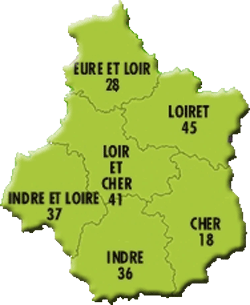 |
CHER |
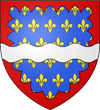 |
|
| Commune |
|
|
| |
 |
La Celle -
Église-Saint-Blaize |
| .A delightful town with friendly people who
are justifiably proud of their church. The church is open and
you may park outside. |
 |


 |
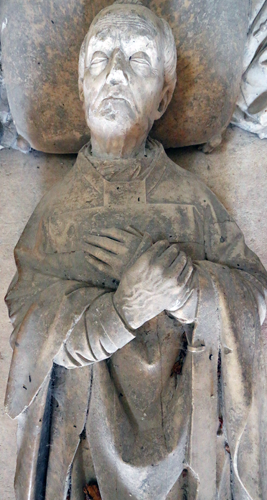
Above, below and left: Tomb and
effigy of Saint Sylvain of
Levroux, legendary apostle
of Berry, said to have been sent to Gaul with St Sylvester by St
Peter himself. He was based at Levroux and is patron saint of
the parish church there. (q.v.)
His remains were said to have been brought from Levroux by
Isabeau de Bourgogne, Dame of Orval and Montrond, to the
chapel of Saint-Sylvain, which is near to La Celle but now
ruinous' around 1463. The tomb and effigy presumably date from
this time. In 1897 the tomb and relics were brought to Saint
Blaize, La Celle, where they remain today.
|

|
| Below: Panels from the four sides of the
tomb chest showing events from the life of Jesus |
 |
 |
 |
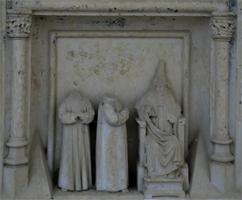 |
| Jesus is baptized by John the Baptist |
The Raising of Lazarus. |
Jesus travels to Jerusalem on the donkey.
Note the man in the tree who frequently appears in this scene |
|
 |
 |
Above: Fragment of a Gallo-Roman tombstone of
Antonilia. Now set in the wall.
Right: 'Here lies Gabriel Morlet, priest of La
Celle Bruère, born in 153 and died in
1830. He was a distinguished scholar and benefactor to this
parish. Pray to God for his soul.' There are other stones in the
church but these are mostly very worn |
|
|
Saint-Amand-Montrond - Musée
Saint-Vic |
This museum has limited opening times so
before planning a visit check
here; entry is free. The museum does not have
its own parking facilities although there were
extensive road works outside the building at the
time of our visit so there may well be street parking in the
future; there are a number of free car parks and
street parking nearby.
|
 |
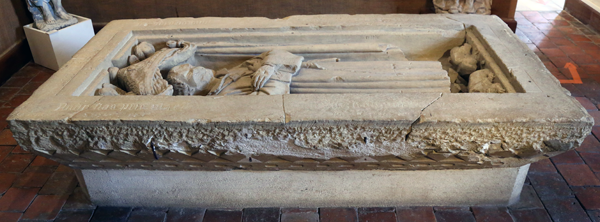
|
I have been unable to discover any
satisfactory information about this unusual monument. The
list writes of it it beingin the town hall: it is not but rather in
the Museum of St Vic, a short walk away. The list also
tells us that it is of a pilgrim and dates from the last quarter
of the XVI century.
However local information - as well as that from the
museum curator - tells us that the monument was in the
town hall, which used to be a church of the Carmelite Fathers
until it was converted into a secular building. There the
monument was discovered and the effigy named Pierre Pèlerin
(Peter Pilgrim). There is an
inscription but I was unable to decipher it. The effigy is
certainly dressed as a pilgrim and carries the relevant symbols
, such as the scallop shells and pilgrim's staff.
Alternatively we were told that he was not a pilgrim at all but
a wealthy merchant of the town who gave land to the church in
which he was buried; as a reward he was represented as a pilgrim
on his monument.
|
|
| |
| Bourges
Cathedral |
| Not Yet Visited |
|
|
| Monastère
de l'Anonciade |
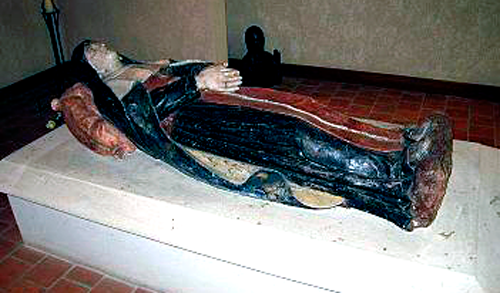
Charles VIII had forcibly married
Anne of Brittany in an attempt to unite Brittany with
France. All of Charles's children had died before him so
when he himself died as a result of an accident (at the
early age of twenty-eight) the throne passed to his
cousin Louis of Orléans, who became king as Louis XII.
Thus the direct Valois line ended.
Louis of Orléans had been harshly brought up by King Louis XI who had
forced him to marry his disabled and possible sterile
daughter, Joanne, in a cynical attempt to eliminated the
Orléans branch of the Valois dynasty. The marriage was
contracted when the couple were infants and took place
when Louis was fourteen and Joanne twelve. However when
the younger Louis became king he had his marriage to
Joanne annulled by Pope Alexander VI (the Borgia Pope)
and he then married his predecessor's widow, Anne of
Brittany, as had been agreed in her initial marriage
contract.
The marriage was annulled not on the grounds of consanguinity, as might
have be expected, but on non consummation of the
marriage, Louis |
|
 |
claiming that the latter was a
result of her physical deformity. The Pope too was
reluctant to anger the French, with the challenge of the
Reformation growing throughout Europe.
Following the annulment of the marriage the King created Joanne
Duchess of Berry and she retired to the capital of her duchy,
Bourges. There she founded a new order of sisters, the Order of
the Annunciation of the Blessed Virgin Mary or the Annonciades
the rules of which were approved by the pope. Joanne took the
veil in 1503 and died in 1505, being buried in her foundation.
During the Religious Wars in France Bourges was sacked by the Huguenots in
1563 and Joanne's monastery and tomb destroyed. It is said that
her body was exhumed and burned and there was a rumour that it
was found uncorrupt. Canonization of Joanne began in 1631 and
she finally became Saint Joanne of Valois in 1950.
|
The list refers to the Monastère
de l'Anonciade at Bourges
which contains the effigy of Joanne as shown above. The
tomb chest is clearly modern. The date is given as the first
quarter of the XVI century. However in Bourges (near the
cathedral at 6 Avenue de 95 E de Ligne) is the Chapel of St
Joanne of France (or Valois) and parts of the conventuel
buildings. This is clearly the same building as it indeed
contains the effigy above. We can therefore assumed that
destroyed means partly destroyed, and later
restored or reassembled. The buildings were acquired by
the City of Bourges in1834, ceded to the state in 1807 and then
assigned to the army. It is now an army chapel.
|
|
| |
| |
| <Centre Index
Page> <Home - Index
-Page> |
| |
|


















